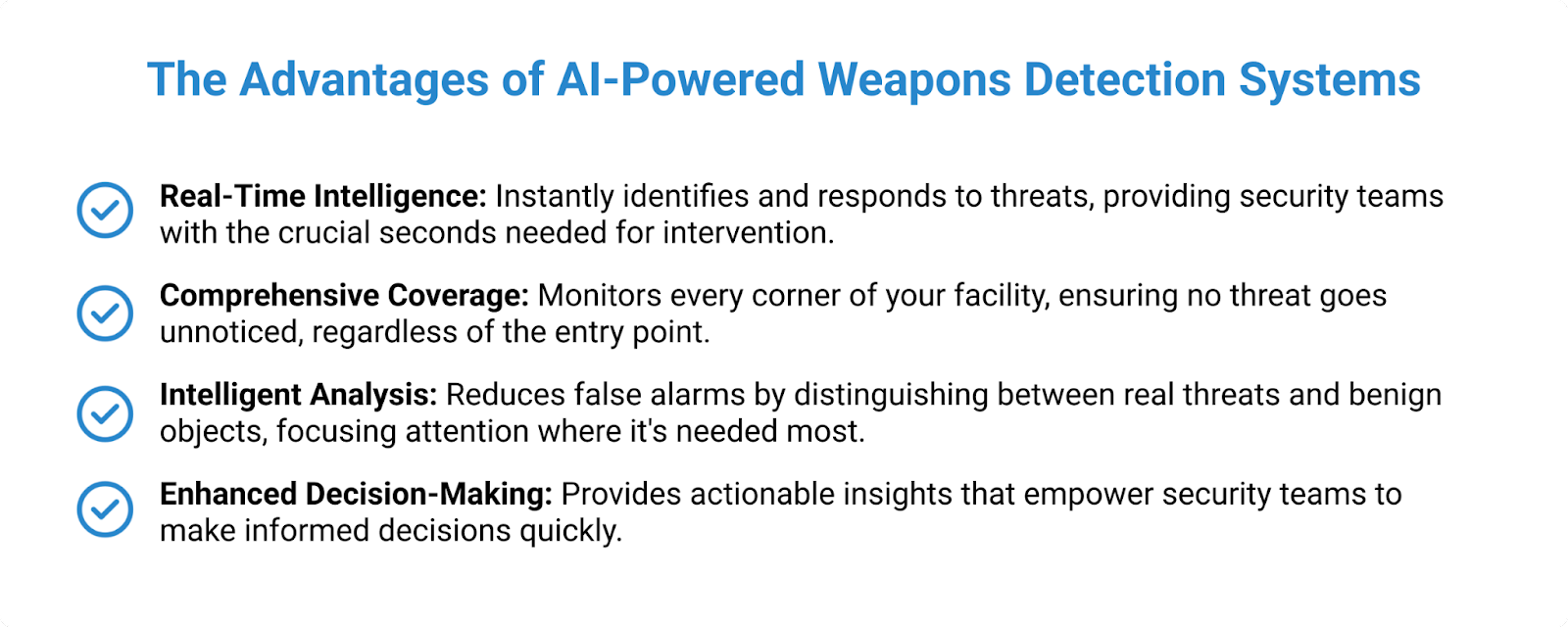What are Weapons Detection Systems?
Weapons detection systems are advanced security technologies designed to spot the presence of weapons in a monitored environment. They mix artificial intelligence (AI) and machine learning to examine real-time data to identify potential threats quickly and accurately. These systems are used in various places like schools, public buildings, and events to enhance safety by allowing for proactive threat detection and response.
In 2023, the U.S. witnessed a disturbing increase in public shootings with 656 mass incidents involving four or more victims, as reported by the Gun Violence Archive. This trend points to a crucial gap in public safety measures and emphasizes an immediate need for smarter security solutions. A key to addressing this challenge is the integration of AI and machine learning-powered weapons detection systems.
These systems enhance the ability of security personnel to quickly identify and respond to threats, enabling a proactive approach to public safety in schools, public spaces, and events. Advancements in weapon detection technology are already playing a big role in the fight against escalating gun violence, aiming to create a safer environment for everyone.
The following sections of this article will explain the limitations of traditional detection systems and the significance of AI-powered weapons detection systems and their impact on public security.
The Limitations of Traditional Weapons Detection Systems
Traditional weapons detection systems like surveillance cameras, metal detectors, and manual checks have been the go-to solutions for public safety. However, as the nature of threats changes, the effectiveness of these methods is declining. Take surveillance cameras for example, they record events, but can't analyze threats in real-time. Metal detectors are only useful at certain entry points, and can overlook threats coming through unchecked areas. Manual security checks, while essential, may vary in their effectiveness and struggle to handle the volume of people in busy public areas.
These weapons detection systems often work separately, lacking the capacity to share data for a comprehensive threat analysis. This approach slows down security teams, impacting their ability to react quickly and efficiently to upcoming threats. Also, the massive amount of data and alerts produced by conventional systems frequently trigger numerous false alarms. The mentioned, in turn, can cause alert fatigue among security staff, raising the likelihood of overlooking real threats.
| Feature | Traditional Weapons Detection Systems | Modern Weapons Detection Systems |
|---|---|---|
| Real-time Threat Analysis | Limited capability; mainly record events without analyzing them in real time. | High capability; use AI and machine learning to analyze threats in real time. |
| Coverage and Detection | Effective only at specific entry points; can miss threats entering through unchecked areas. | Comprehensive coverage; capable of detecting threats across multiple areas and entry points. |
| Integration and Data Sharing | Often work in isolation without the ability to share data for comprehensive analysis. | Highly integrated; can share data across platforms for a unified threat analysis. |
| Response to Threats | Slower response due to manual monitoring and the need to review footage. | Quick response enabled by real-time alerts and automated threat tracking. |
| Rate of False Alarms | High rate of false alarms, leading to alert fatigue among security personnel. | Reduced false alarms through precise detection capabilities and intelligent analysis. |
| Scalability | Limited by physical infrastructure and human resources. | Easily scalable with software updates and integration with existing digital systems. |
| User Interface and Accessibility | Often complex, requiring specialized training for effective use. | User-friendly interfaces designed for accessibility and ease of use, minimizing training requirements. |
To sum up, traditional security methods have their drawbacks: they react instead of being proactive, they're standalone rather than integrated, and they can be overwhelming. These shortcomings highlight the need for a revised approach to security, one that can adapt to and anticipate threats.
The Growing Influence of AI in Security
Artificial Intelligence (or AI) is becoming a part of security systems and is definitely a game-changer, paving the way for proactive identification and handling of threats. What sets AI-powered weapons detection systems apart from the conventional security measures is their ability to analyze real-time data from various sources and pinpoint potential threats with exceptional speed and precision. This change is driven by machine learning algorithms which use enormous volumes of data to identify patterns and outliers that could signal a threat, such as the presence of weapons.
AI's ability to constantly watch and analyze video streams enables the weapon detection system to identify weapons in physical environments instantly. This gives security teams vital extra time to step in before things get out of hand. Plus, this on-the-spot processing seriously cuts down false alarms, which are a typical problem with traditional security systems. This makes life easier for security staff, freeing them up to concentrate on real threats.

Moreover, the use of AI in security goes beyond just detecting weapons. It's also used for monitoring crowd patterns, identifying unattended items, and other potential safety hazards. AI-based weapon detection moves us away from the reactive nature of old security systems and instead offers a preventative, efficient way to protect public areas.
Bringing It All Together: The Power of Real-Time Visual Intelligence Security Platforms
Real-time visual intelligence platforms for security have really stepped up the game in threat detection and management. These platforms analyze video surveillance data incorporating AI-powered weapons and other incident detection systems — into one integrated interface. This doesn't just make identifying and responding to threats a smoother process, but it also empowers security teams with real-time analytics and critical insights.
A key benefit of such security platforms is the live situational awareness they offer. Security teams can get immediate alerts about potential threats, such as the spotting of weapons in a watched area. What's more important are the advanced features of these platforms. For example, VOLT AI can follow the movement of these threats across various cameras and locations, providing a dynamic, all-encompassing view of a situation as it develops. This level of detail is vital for launching an effective response, making sure resources are sent exactly where they're needed the most.
Additionally, these platforms are designed with user experience in mind, featuring intuitive interfaces that simplify the complex task of security management. This accessibility ensures that security personnel can quickly interpret and act on the vast amounts of data presented to them, a critical factor in high-pressure situations.
Real-time video intelligence platforms such as VOLT, which enhance existing systems rather than replace them, provide a cost-effective and efficient method to improve security capabilities - this makes the transition easier for organizations aiming to improve their security measures.
Upgrading Your Security with VOLT
With the growing complexity of threats, adopting advanced, reliable security solutions is not just beneficial — it's critical for public safety. The move toward AI-powered weapons/incident detection systems and integrated security platforms is a substantial step towards improving public safety in a preemptive, efficient manner. VOLT represents this change by providing a complete solution that provides real-time video intelligence.
VOLT’s platform is built to boost the performance of security teams, enabling them to detect and respond to threats with unprecedented speed and accuracy. By leveraging the power of AI for visual tracking across multiple locations, VOLT transforms the conventional approach to security into a more dynamic and effective strategy. It's not just about detecting threats, it's about giving a comprehensive perspective on security that supports swift, informed actions in critical situations.
The advantages of integrating VOLT extend beyond the benefits of a weapons detection system and immediate threat detection. VOLT AI revolutionizes traditional security approaches by leveraging AI-powered video intelligence for immediate, real-time responses to incidents, ensuring rapid and accurate threat detection. By unifying existing camera systems, VOLT AI offers dynamic visual tracking across multiple locations and focuses on actionable alerts. Furthermore, VOLT AI's model emphasizes economic efficiency, requiring no upfront costs or new hardware, and supports a simple per-camera pricing model, making it an adaptable solution that enhances security without the burden of additional costs.
Discover how VOLT is redefining safety with cutting-edge solutions. Request a demo to learn more about weapon detection systems and how VOLT can improve the safety of your organization or community.


